Como pinté una espiga de gladiolo, paso a paso # 8 / How I painted a Gladiolus spike, “step by step” # 8.
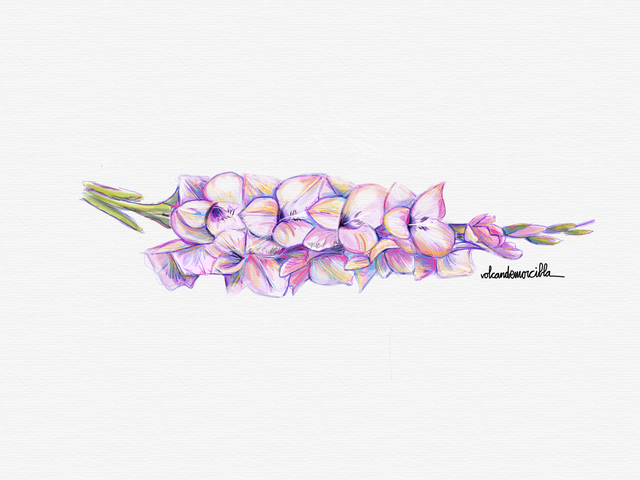
Siguiendo con el proyecto “paso paso”, hoy os voy a mostrar como pinté un Gladiolo. Este dibujo decora mi publicación con el Haiku número 12.
Proyecto “Paso a paso”
Este proyecto consiste en iros mostrando cómo voy haciendo un dibujo y, a la vez, indicaros algún consejo que os pueda resultar de utilidad.
Como os he indicado en otras ocasiones, lo primero es deciros que utilizó el programa Sketches y desarrollo la pintura en el iPad.
Esta forma de dibujar me resulta práctica porque me permite hacer correcciones. Puedo dar “pasos atrás” si algo no me gusta o no me ha quedado bien.
Pintar en el iPad es mas sencillo. Todo el montaje previo que requiere pintar al óleo o con acuarelas es mucho mas simple. También, está la ventaja de que esta forma de pintar es muy limpia y no produce olores. Mi familia lo agradece.
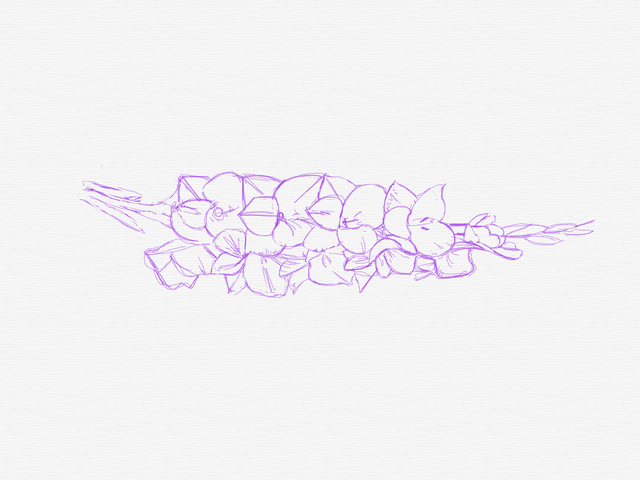
Lo primero hay que hacer un dibujo. Empleé la herramienta lápiz con un grosor muy fino y con un color acorde al de las flores y tallo. Así pinté la silueta que enmarcará los futuros colores.
Se pueden hacer correcciones con la goma, para ir mejorando y rectificando progresivamente el dibujo.
Para facilitar el dibujo, los menos habilidosos pueden calcar desde una fotografía porque el programa permite hacer capas.
Es primordial contar con un buen dibujo. Para obtener un buen resultado es muy importante contar con un buen diseño de base. Vale la pena gastar tiempo en realizar un buen dibujo antes de comenzar a colorear.
Un buen dibujo es la base de un buen resultado.
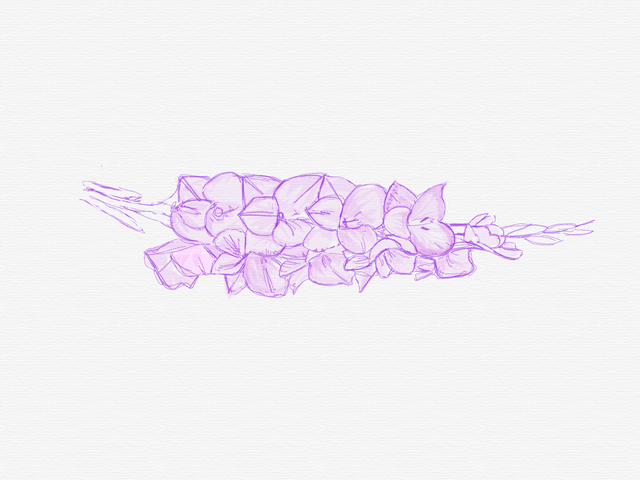
Luego fui rellenando los espacios con color. En este caso preferí utilizar sólo acuarela.
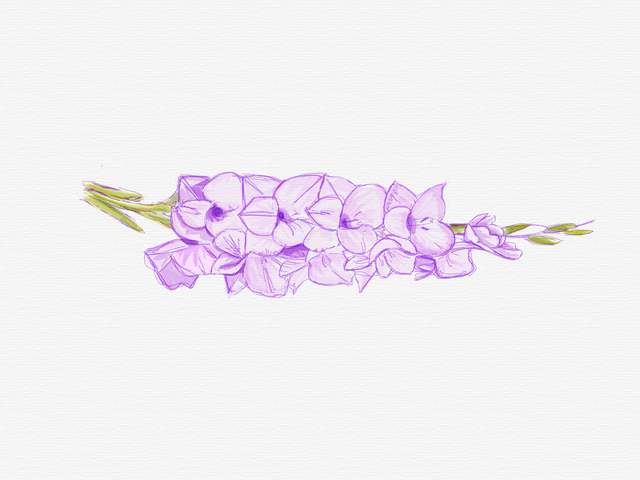
Lo que resulta mas atractivo de la acuarela es su transparencia y sus puntos de luz. Al principio, puse el color muy transparente para ir, progresivamente, aplicando capas y aumentar su opacidad e intensidad del color.
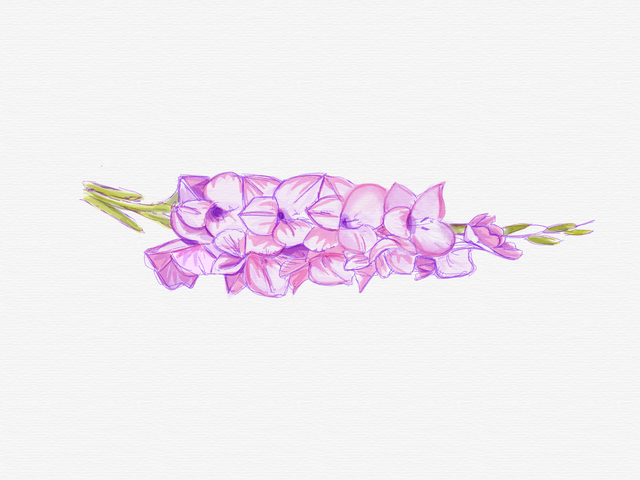
En la acuarela, debemos meditar y decidir antes de aplicar el color, donde quedarán los puntos mas claros y los blancos. Hay que cuidar bien donde se aplica la capa de color puesto que la acuarela no admite marcha atrás, ni rectificación.
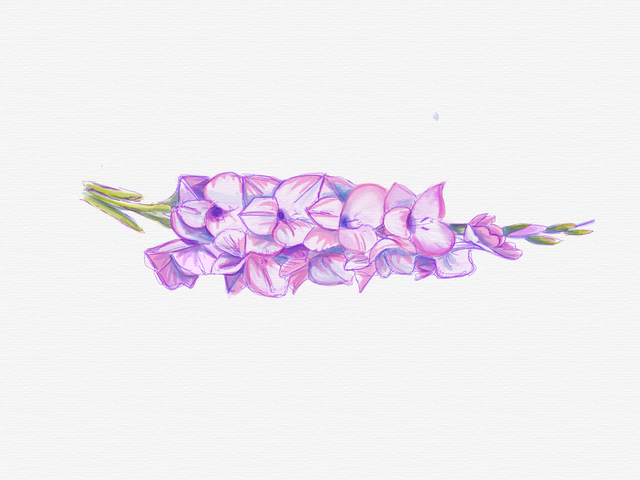
Progresivamente, fui dando diversas capas de acuarela dejando algunos espacios en blanco. Se debe planear de antemano cuáles serán las zonas de mayor color y por tanto menos trasparentes.
Insisto, es muy importante determinar antes de comenzar a aplicar color, los espacios que quedarán en blanco o muy transparentes.
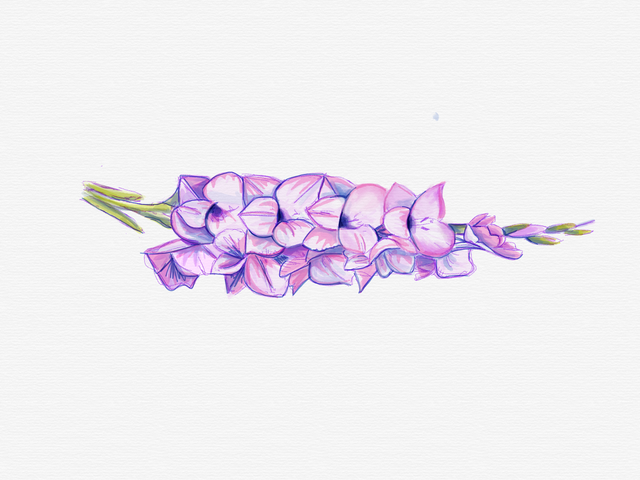
Fui añadiendo colores distintos para que no fuera todo tan homogéneo. Al final añadí pequeños toques de amarillo y de azul para resaltar las partes mas iluminadas y las sombreadas.
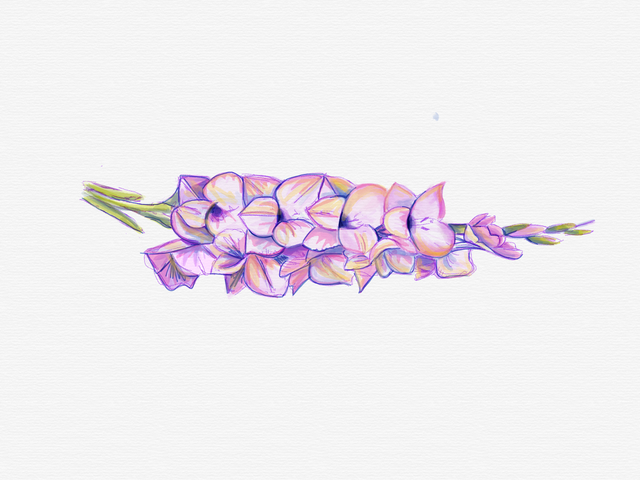
Para darle homogeneidad y que todo el trabajo esté conjuntado es muy importante repetir los mismos colores y tonos a lo largo de todo del dibujo. Para integrar todas las zonas de la pintura entre sí, en todos los lados tiene que haber colores parecidos o similares.
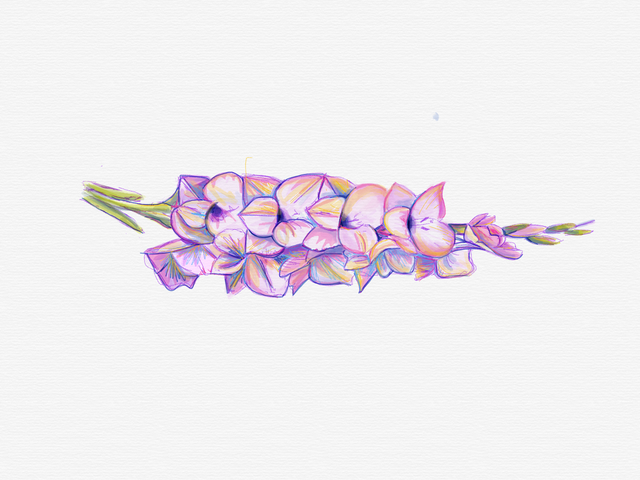
Es decir, si se aplica un amarillo en una zona hay que repetir ese amarillo por todo el cuadro o si se aplica un rosa, ese mismo rosa debe estar sutilmente repartido por toda la pintura. Aprendí esto observando los bodegones del famoso pintor Paul Cézanne.
El proceso de pintura lo fui construyendo desde lo claro a lo oscuro. Así, fui resaltando las zonas más oscuras y dejando sin tocar las mas luminosas.
Pretendí obtener un resultado imperfecto pero sugerente. No suele dar buenos resultados que esté todo excesivamente delimitado y perfilado. Como yo suelo decir: No me gusta que quede todo especialmente “relamido”. Borré algunos bordes muy llamativos para dar un mayor volumen y que la pintura fuera menos plana.
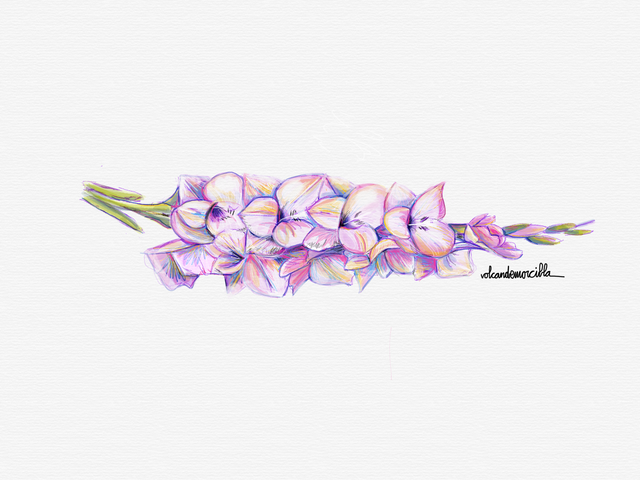
Llega un momento en que la pintura está terminada. Lo importante es saber parar a tiempo y darse cuenta de que la pintura está completada, evitando así una excesiva perfección.
Espero que esta guía os haya sido útil y práctica. Si tenéis alguna pregunta, con mucho gusto os la puedo intentar contestar. De la misma forma, si me queréis dar algún tipo de consejo, también será bienvenido. Espero vuestros comentarios.
How I painted a Gladiolus spike. "Step by step"
Continuing with the project "step step", today I am going to show you how I painted the Gladiolus that decorates my publication that contains the Haiku number 12.
"Step by step" project
This project consists of showing you how I am doing a drawing and, at the same time, to indicate some advice you may find useful.
As I have indicated on other occasions, the first thing is to tell you that he used the Sketches program and developed the painting on the iPad. This way of drawing is practical because it allows me to make corrections. I can take "back steps" if something I do not like or it has not been good for me.
Painting on the iPad is easier. All the previous assembly that requires painting in oil or with watercolors is much easier. Also, there is the advantage that this way of painting is very clean and does not produce odors. My family thanks him.
The first thing you have to do is draw a picture. I use the pencil tool with a very thin thickness and with a color according to the colors of the flowers and stem. So I painted a silhouette that frames the future colors. You can make corrections with the rubber to gradually improve and rectify the drawing. To facilitate the drawing, it can be traced from a photograph because the program allows to make layers.
It is essential to have a good drawing. To obtain a good result it is very important to have a good basic drawing. It is worth spending time to make a good drawing before coloring.
A good drawing is the basis of a good result.
Then I filled in the spaces with color. In this case I preferred to use only watercolor.
What is most attractive about watercolor is its transparency and its points of light. At first, I put the color very transparent to go, progressively, applying layers and increase its opacity and intensity of color.
In watercolor, we must meditate and decide before applying the color, where the clearest points and whites will remain. You have to take good care of where the layer of color is applied since the watercolor does not support reverse or rectification.
Progressively, I gave several watercolor layers leaving some blank spaces. It should be planned in advance what will be the areas of greater color and therefore less transparent. In the same way, I insist, it is very important to determine before starting to apply color, spaces that will remain blank or very transparent.
I was adding different colors so that everything was not so homogeneous. At the end I added small touches of yellow and blue to highlight the most lighted and shaded parts.
To give homogeneity and all the work is combined is very important to repeat the same colors and shades throughout the drawing. To integrate all areas of the paint with each other, on all sides there must be similar or similar colors.
That is, if a yellow is applied in an area, that yellow should be repeated throughout the painting or if a rose is applied, that same rose should be subtly distributed throughout the painting. I learned this by observing the still lifes of the famous painter Paul Cézanne.
I was building the painting process from light to dark. So, I was highlighting the darkest areas and leaving the brightest without touching.
The most beautiful of the watercolor is its effect of transparency and luminosity.
I tried to obtain an imperfect but suggestive result. It does not usually give good results that everything is excessively delimited and outlined. As I usually say: I do not like that everything especially "relaxed".
There comes a time when the painting is finished. The important thing is to know how to stop in time and realize that the painting is completed, thus avoiding excessive perfection.
I hope this guide has been useful and practical. If you have any questions, I can gladly answer. In the same way, if you want to give me some kind of advice, you will also be welcome. I await your comments.

Cómo lo hago
Fotografía la tomé con mi iPhone X.
Los dibujos los hice en el iPad con el programa Sketches.
For the photography I use my iPhone X.
For the drawings, I use the Sketches program and paint them on the tablet.
Si quieres ver como lo hago, visualiza estos cinco enlaces de publicaciones previas.
If you want to see how I do it, visualize these five links from previous publications.
Cómo pinté con acuarela una rosa


Original design for @talentclub de @carlos-cabeza
Las fotos son mías y originales. También, soy el autor del dibujo separador.
¡Espero tus comentarios!
The photos are originals and mine. Also, I am the author of the separator drawing.
I await your comments.
¡Buen Camino!
Hermosa tu técnica, muestra mucha dedicación y amor, la misma que le pones a tus tomas fotográficas.
Quiero aprovechar para invitarte a la curación en vivo que se efectuara mañana a las 9 Pm hora de Venezuela, en el servidor de El Arca, ajústala a tu hora local, ya que desconozco nuestra diferencia de horario. Espero que puedas participar y nos deleites como siempre con tu trabajo. un abrazo.
Siempre me había preguntado como hacías tus dibujos, me encantan como lucen de separadores, es un hermoso trabajo.
¡Feliz viernes!! :)
Jejejej secreto desvelado!! Gracias 😊
Posted using Partiko iOS
Mientras más minúsculas las fotografía seguro será mayor la dificultad. En un palabra, pacienciaaa jajaja muy bueno smigo.
Te habrás dado cuenta a estas alturas que me gustan los detallitos minúsculos jejejej 🤗
Posted using Partiko iOS
Uff que bien! Qué subidón 😊
Posted using Partiko iOS